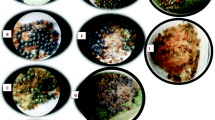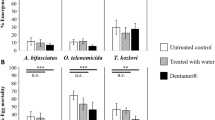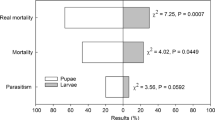Abstract
Trichogrammatidae (Hymenoptera) egg parasitoids are released for the fall armyworm Spodoptera frugiperda J.E. Smith (Lepidoptera: Noctuidae) management, and weeds are controlled mainly with glyphosate in corn Zea mays L. (Poales: Poaceae) crops. A glyphosate-based herbicide was sprayed at 13.94 L ha−1 on eggs of the worldwide used alternative host, the Mediterranean flour moth Anagasta kuehniella Zeller (Lepidoptera: Pyralidae) parasitized by 10 Trichogrammatidae species, in a free-choice test. Parasitism, female emergence and female-biased sex ratio of these parasitoids were evaluated. Parasitism by Trichogramma acacioi Brun, Moraes & Soares, Trichogramma bennetti Nagaraja & Nagarkatti, Trichogramma brasiliensis Ashmead, Trichogramma galloi Zucchi, and Trichogramma pretiosum Riley was lower with glyphosate. This herbicide reduced the Trichogrammatoidea annulata de Santis, T. bennetti, Trichogramma bruni Nagaraja, Trichogramma demoraesi Nagaraja, T. galloi, and T. pretiosum female emergence. Female-biased sex ratio of T. annulata, T. bennetti, T. bruni, T. galloi, and T. pretiosum was lower with glyphosate. Glyphosate did not reduce the Trichogramma soaresi Nagaraja parasitism and female emergence, and, therefore, the use of this species has potential to be compatible with glyphosate.
Similar content being viewed by others
References
Beserra EB, Querino RB, Parra JRP (2003) Occurrence of gynandromorphism in Trichogramma pretiosum Riley (Hymenoptera: Trichogrammatidae). Neotrop Entomol 32:507–509
Bueno A de F, Bueno RCO de F, Parra JRP, Vieira SS (2008) Effects of pesticides used in soybean crops to the egg parasitoid Trichogramma pretiosum. Ciênc. Rural 38:1495–1503
de Amarante Junior OP, dos Santos TCR, Brito NM (2002) Glyphosate: properties, toxicity, use and legislation. Quím Nova 25:589–593
Fickett ND, Boerboom CM, Stoltenberg DE (2013) Predicted corn yield loss due to weed competition prior to postemergence herbicide application on Wisconsin farms. Weed Technol 27:54–62
Foerster MR, Foerster LA (2009) Effects of temperature on the immature development and emergence of five species of Trichogramma. Biocontrol 54:445–450
Giolo FP, Grützmacher AD, Procópio SO, Manzoni CG, Lima CAB, Nörnberg SD (2005) Side-effects of glyphosate formulations on Trichogramma pretiosum (Hymenoptera: Trichogrammatidae). Planta Daninha 23:457–462
Khan MA, Khan H, Ruberson JR (2015) Lethal and behavioral effects of selected novel pesticides on adults of Trichogramma pretiosum (Hymenoptera: Trichogrammatidae). Pest Manag Sci 71:1640–1648
Leite GLD, de Paulo PD, Zanuncio JC, Alvarenga AC, Soares MA, Tavares W de S, Tuffi-Santos LD, Spínola-Filho PR de C (2015) Effects of atrazine-based herbicide on emergence and sex ratio of Trichogrammatidae (Hymenoptera). Fla Entomol 98:899–902
Leite GLD, de Paulo PD, Zanuncio JC, Tavares W de S, Alvarenga AC, Dourado LR, Bispo EPR, Soares MA (2017a) Nicosulfuron plus atrazine herbicides and Trichogrammatidae (Hymenoptera) in no-choice test: selectivity and hormesis. Bull Environ Contam Toxicol 99:589–594
Leite GLD, de Paulo PD, Zanuncio JC, Tavares W de S, Alvarenga AC, Dourado LR, Bispo EP, Soares MA (2017b) Herbicide toxicity, selectivity and hormesis of nicosulfuron on 10 Trichogrammatidae (Hymenoptera) species parasitizing Anagasta (= Ephestia) kuehniella (Lepidoptera: Pyralidae) eggs. J Environ Sci Health B 52:70–76
Lima MS, Silva PSL, Oliveira OF, Silva KMB, Freitas FCL (2010) Corn yield response to weed and fall armyworm controls. Planta Daninha 28:103–111
Madeira F, Pons X (2015) Effects of weed density on the dispersal of Orius majusculus Reuter (Heteroptera Anthocoridae) within maize. J Appl Entomol 139:712–720
Manzoni CG, Grützmacher AD, Giolo FP, Härter W da R, Castilhos RV, Paschoal MDF (2007) Side-effects of pesticides used in integrated production of apples to parasitoids of Trichogramma pretiosum Riley and Trichogramma atopovirilia Oatman & Platner (Hymenoptera: Trichogrammatidae). BioAssay 2:1–11
Milanez AM, Pratissoli D, Polanczyk RA, Bueno A de F, Tufik CBA (2009) Evaluation of Trichogramma spp. for the control of Trichoplusia ni. Pesqui Agropecu Bras 44:1219–1224
Morandi Filho WJ, Müller C, de Lima CAB, Härter WR, Giolo FP, Grützmacher AD (2008) Evaluation of methodologies for testings the selection of products that regulate the growth of Trichogramma pretiosum (Riley, 1879) (Hymenoptera: Trichogrammatidae) in the cultivation of apple in laboratory conditions. Idesia 26:78–85
Oliveira HN, Antigo MR, Carvalho GA, Glaeser DF (2014) Effect of selectivity of herbicides and plant growth regulators used in sugarcane crops on immature stages of Trichogramma galloi (Hymenoptera: Trichogrammatidae). Planta Daninha 32:125–131
Pascoaloto IM, Andreotti M, da Cruz SS, Sabbag OJ, Borghi E, de Lima GC, Modesto VC (2017) Economic analysis of sorghum consortia with forages or with dwarf pigeon pea succeeded by soybean or corn. Pesqui Agropecu Bras 52:833–840
Passini RA, Grützmacher AD, Spagnol D, Zantedeschi R, Friedrich FF (2017) Persistence of desiccant herbicides applied to transgenic maize on Trichogramma pretiosum Riley, 1879 (Hymenoptera: Trichogrammatidae). Rev Ciênc Agron 48:175–181
Pratissoli D, Oliveira HN, Gonçalves JR, Zanuncio JC, Holtz AM (2004) Changes in biological characteristics of Trichogramma pretiosum (Hym.: Trichogrammatidae) reared on eggs of Anagasta kuehniella (Lep.: Pyralidae) for 23 generations. Biocontrol Sci Technol 14:313–319
Prezotti L, Parra JRP, Vencovsky R, Coelho ASG, Cruz I (2004) Effect of the size of the founder population on the quality of sexual populations of Trichogramma pretiosum, in laboratory. Biol Control 30:174–180
Rajablarijani HR, Mirshekari B, Alikhani MA, Rashidi V, Farahvash F (2014) Sweet corn weed control and yields in response to sowing date and cropping systems. HortScience 49:289–293
Rosa R (2015) The effect of winter catch crops on weed infestation in sweet corn depending on the weed control methods. J Ecol Eng 16:125–135
SAEG (2007) Sistema para Análises Estatísticas, Versão 9.1. Fundação Arthur Bernardes, UFV, Viçosa
San Martín C, Andújar D, Fernández-Quintanilla C, Dorado J (2015) Spatial distribution patterns of weed communities in corn fields of central Spain. Weed Sci 63:936–945
Soares MA, Leite GLD, Zanuncio JC, Rocha SL, de Sá VGM, Serrão JE (2007) Flight capacity, parasitism and emergence of five Trichogramma (Hymenoptera: Trichogrammatidae) species from forest areas in Brazil. Phytoparasitica 35:314–318
Soares MA, Leite GLD, Zanuncio JC, de Sá VGM, Ferreira CS, Rocha SL, Pires EM, Serrão JE (2012) Quality control of Trichogramma atopovilia and Trichogramma pretiosum (Hym.: Trichogrammatidae) adults reared under laboratory conditions. Braz Arch Biol Technol 55:305–311
Souza JR, Carvalho GA, Moura AP, Couto MHG, Maia JB (2013) Impact of insecticides used to control Spodoptera frugiperda (J.E. Smith) in corn on survival, sex ratio, and reproduction of Trichogramma pretiosum Riley offspring. Chil J Agric Res 73:122–127
Spínola-Filho PR de C, Leite GLD, Soares MA, Alvarenga AC, de Paulo PD, Tuffi-Santos LD, Zanuncio JC (2014) Effects of duration of cold storage of host eggs on percent parasitism and adult emergence of each of ten Trichogrammatidae (Hymenoptera) species. Fla Entomol. 97:14–21
Stefanello Jr GJ, Grützmacher AD, Pasini RA, Bonez C, Moreira DC, Spagnol D (2011) Selectivity of herbicides registered for corn at the immature stages of Trichogramma pretiosum (Hymenoptera: Trichogrammatidae). Planta Daninha 29:1069–1077
Stefanello Júnior GJ, Grützmacher AD, Grützmacher DD, Lima CAB, Dalmozo DO, Paschoal MDF (2008) Selectivity of herbicides registered on corn to Trichogramma pretiosum (Hymenoptera: Trichogrammatidae). Planta Daninha 26:343–351
Stefanello Júnior GJ, Grützmacher AD, Spagnol D, Pasini RA, Bonez C, Moreira DC (2012) Persistence of pesticides used in corn field to the parasitoid Trichogramma pretiosum Riley, 1879 (Hymenoptera: Trichogrammatidae). Ciênc Rural 42:17–23
Sterk G, Hassan SA, Baillod M, Bakker F, Bigler F, Blümel S, Bogenschütz H, Boller E, Bromand B, Brun J, Calis JNM, Coremans-Pelseneer J, Duso C, Garrido A, Grove A, Heimbach U, Hokkanen H, Jacas J, Lewis G, Moreth L, Polgar L, Rovesti L, Samsoe-Peterson L, Sauphanor B, Schaub L, Stäubli A, Tuset JJ, Vainio A, Van de Veire M, Viggiani G, Viñuela E, Vogt H (1999) Results of the seventh joint pesticide testing programme carried out by the IOBC/WPRS-working group “Pesticides and Beneficial Organisms”. Biocontrol 44:99–117
Stouthamer R, Luck RF, Hamilton WD (1990) Antibiotics cause parthenogenetic Trichogramma to revert to sex. Proc Natl Acad Sci U S A 87:2424–2427
Tavares W de S (2010) Costs of a biofactory of Trichogramma pretiosum Riley for the control of fall armyworm in maize. EntomoBrasilis 3:49–54
Tavares W de S, Cruz I, Petacci F, de Assis Júnior SL, Freitas S de S, Zanuncio JC, Serrão JE (2009) Potential use of Asteraceae extracts to control Spodoptera frugiperda (Lepidoptera: Noctuidae) and selectivity to their parasitoids Trichogramma pretiosum (Hymenoptera: Trichogrammatidae) and Telenomus remus (Hymenoptera: Scelionidae). Ind. Crop. Prod. 30:384–388
Tavares WS, Cruz I, Silva RB, Serrão JE, Zanuncio JC (2011) Prey consumption and development of Chrysoperla externa (Neuroptera: Chrysopidae) on Spodoptera frugiperda (Lepidoptera: Noctuidae) eggs and larvae and Anagasta kuehniella (Lepidoptera: Pyralidae) eggs. Maydica 56:283–289
Tukey J (1949) Comparing individual means in the analysis of variance. Biometrics 5:99–114
Watanabe M, Tagami Y, Miura K, Kageyama D, Stouthamer R (2012) Distribution patterns of Wolbachia endosymbionts in the closely related flower bugs of the genus Orius: Implications for coevolution and horizontal transfer. Microb Ecol 64:537–545
Xin Z, Yu Z, Erb M, Turlings TC, Wang B, Qi J, Liu S, Lou Y (2012) The broad-leaf herbicide 2,4-dichlorophenoxyacetic acid turns rice into a living trap for a major insect pest and a parasitic wasp. New Phytol 194:498–510
Acknowledgements
To Conselho Nacional de Desenvolvimento Científico e Tecnológico (CNPq), Coordenação de Aperfeiçoamento de Pessoal de Nível Superior (CAPES), Fundação de Amparo à Pesquisa do Estado de Minas Gerais (FAPEMIG), and Programa Cooperativo sobre Proteção Florestal (PROTEF) of the Instituto de Pesquisas e Estudos Florestais (IPEF) for financial support.
Author information
Authors and Affiliations
Corresponding author
Ethics declarations
Conflict of interest
The authors declare that they have no conflict of interests.
Human and animal rights
The article does not contain any human and animal rights.
Additional information
Publisher's Note
Springer Nature remains neutral with regard to jurisdictional claims in published maps and institutional affiliations.
Rights and permissions
About this article
Cite this article
Pontes, J.P., Leite, G.L.D., Bispo, E.P.R. et al. A glyphosate-based herbicide in a free-choice test on parasitism, emergence, and female-biased sex ratio of 10 Trichogrammatidae. J Plant Dis Prot 127, 73–79 (2020). https://doi.org/10.1007/s41348-019-00277-x
Received:
Accepted:
Published:
Issue Date:
DOI: https://doi.org/10.1007/s41348-019-00277-x




